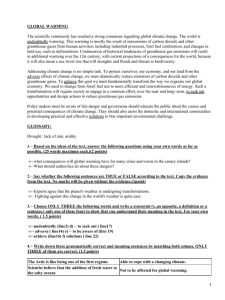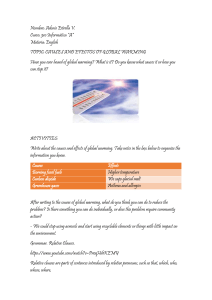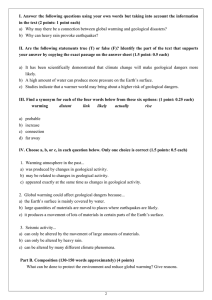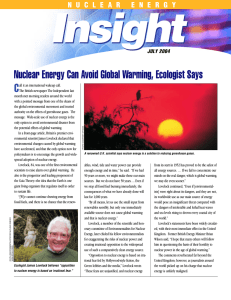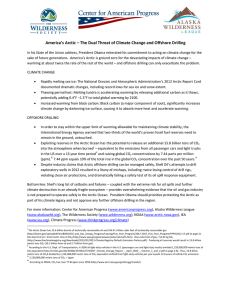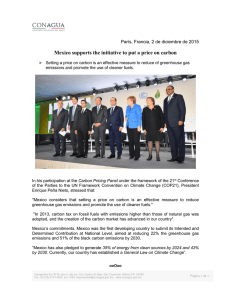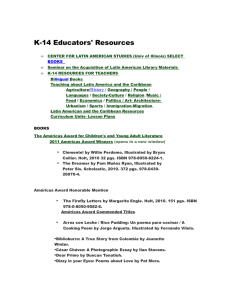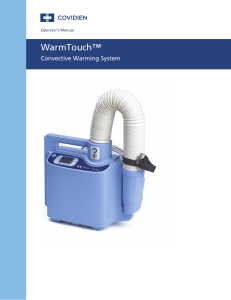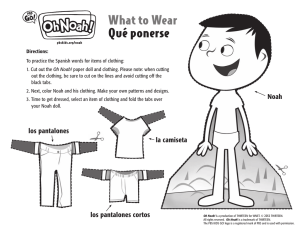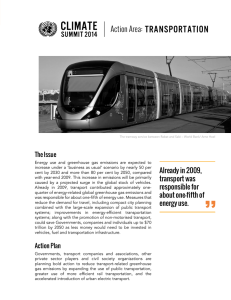Global Warming Lesson Plan: Greenhouse Effect & Climate Change
Anuncio
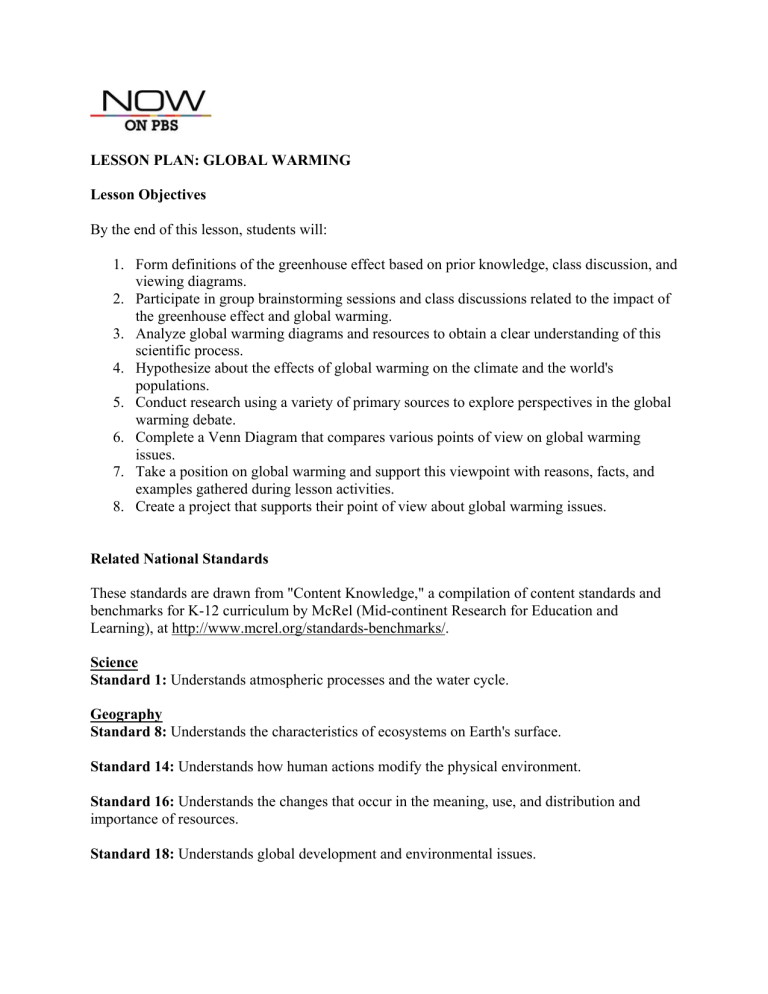
LESSON PLAN: GLOBAL WARMING Lesson Objectives By the end of this lesson, students will: 1. Form definitions of the greenhouse effect based on prior knowledge, class discussion, and viewing diagrams. 2. Participate in group brainstorming sessions and class discussions related to the impact of the greenhouse effect and global warming. 3. Analyze global warming diagrams and resources to obtain a clear understanding of this scientific process. 4. Hypothesize about the effects of global warming on the climate and the world's populations. 5. Conduct research using a variety of primary sources to explore perspectives in the global warming debate. 6. Complete a Venn Diagram that compares various points of view on global warming issues. 7. Take a position on global warming and support this viewpoint with reasons, facts, and examples gathered during lesson activities. 8. Create a project that supports their point of view about global warming issues. Related National Standards These standards are drawn from "Content Knowledge," a compilation of content standards and benchmarks for K-12 curriculum by McRel (Mid-continent Research for Education and Learning), at http://www.mcrel.org/standards-benchmarks/. Science Standard 1: Understands atmospheric processes and the water cycle. Geography Standard 8: Understands the characteristics of ecosystems on Earth's surface. Standard 14: Understands how human actions modify the physical environment. Standard 16: Understands the changes that occur in the meaning, use, and distribution and importance of resources. Standard 18: Understands global development and environmental issues. Health Standard 2: Knows environmental and external factors that affect individual and community health. World History Standard 44: Understands the search for community, stability, and peace in an interdependent world. Language Arts Writing, Standard 4: Gathers and uses information for research purposes. Reading, Standard 7: Uses reading skills and strategies to understand and interpret a variety of informational texts. Listening and Speaking Standard 8: Uses listening and speaking strategies for different purposes. Standard 9: Uses viewing skills and strategies to understand and interpret visual media. Standard 10: Understands the characteristics and components of the media. Thinking and Reasoning Standard 1: Understands and applies the basic principles of presenting an argument. Standard 2: Understands and applies the basic principles of logic and reasoning. Standard 3: Effectively uses mental processes that are based on identifying similarities and differences. Standard 6: Applies decision-making techniques. Estimated Time to Complete Lesson Four or five 50-minute class periods, plus some time outside of class to complete the final project. Some of the in-class activities in this lesson plan could be completed for homework, if preferred. Materials Needed • Internet access for research and viewing broadcasts, transcripts, podcasts, etc., from NOW and other online resources • Access to content from three NOW broadcasts: The Heat Over Global Warming http://www.pbs.org/now/shows/304/ Climate Change and the Media Senate Hearings http://www.pbs.org/now/shows/249/climate-change.html God and Global Warming http://www.pbs.org/now/shows/343/index.html • • Handout: Global Warming Venn Diagram (PDF file) Handout: Global Warming Project Ideas (PDF file) Backgrounder for Teachers Is human activity bringing about alarming global warming scenarios and related catastrophes? Or is such thinking a myth brought about by flawed or incomplete science? Finding the answers to these questions has turned global warming into a highly politicized and contentious issue. Until about 1960, most scientists thought it implausible that humans could actually affect average global temperatures. (See NOW's “History of Global Warming” at http://www.pbs.org/now/science/climatechange.html) Today, most scientists agree that Earth's temperature has risen over the past century and that carbon dioxide is one of the primary greenhouse gases that contribute to global warming. Disagreement persists, however, over whether or not global climate change is a normal environmental variation, and over how big of a problem global warming could become for the planet. Amidst such controversy, world leaders have met and outlined legal rules, known as the Kyoto Protocol, to limit the emissions of greenhouse gases. One hundred forty countries that collectively represent 61.6% of greenhouse gas emissions worldwide have ratified the Kyoto Protocol. The United States does not support the Kyoto Protocol and disagrees with a number of its provisions. Instead, the U.S. is funding additional scientific research on the causes and effects of global warming, encouraging climate change technology research and development efforts, looking at how its own federal and state laws can regulate greenhouse gas emissions in the U.S., backing the research and development of renewable energy sources, and pursuing other strategies that it believes will address global climate change without major upsets to the U.S. economy. Assumed Student Prior Knowledge Students should be familiar with the terms, "global warming," the "greenhouse effect," and "greenhouse gases." Also, they should be aware that the U.S. is a leading producer of greenhouse gas emissions that contribute to global warming. Teaching Strategy Part 1: Reviewing the Facts: What is The Greenhouse Effect? (30 minutes) 1. Before class begins, post the term, "greenhouse effect" where students can see it. 2. To begin the class, ask students to think without talking about a definition for the greenhouse effect. Give them a minute to formulate their ideas and then have them write down their definitions so they can share them. 3. At the end of the allotted time, ask students to share their definitions with one or two other students sitting nearby and compare the similarities and differences in their definitions. Allow a few minutes for student pairs or groups to then combine their definitions into one that they believe is the most accurate. 4. Begin a class discussion by asking several pairs/groups to share their definitions of the greenhouse effect. 5. Next, show students a Flash animation (found at the U.S. Environmental Protection Agency's Web site: http://www.epa.gov/globalwarming/kids/global_warming_version2.html) that accurately describes the greenhouse effect and how it likely contributes to global warming. You might have students take turns reading the dialogue balloons for the characters shown on the site. Alternatively, the EPA Web site provides a simple diagram with text explanation of the greenhouse effect at: http://www.epa.gov/globalwarming/kids/greenhouse.html. Ask students to make any corrections to their definitions based on what they've learned. Part 2: Making Predictions about the Effects of Global Warming (20 minutes) With an understanding of the greenhouse effect and global climate change, students can now make predictions about the potential impact of global warming. 1. Ask students to hypothesize about how the world's climate could change over the next 100 years if humans do nothing to limit the levels of their greenhouse gas emissions. Have them also make predictions about the effects such climate changes could have on humans. 2. Working in pairs, small groups, or as a class, students should brainstorm a list of their ideas related to these questions. Each student should record a copy of the list in order to refer back to it later in the lesson. Part 3: Comparing Points of View on Global Warming (90 minutes) 1. Begin by discussing the fact that not everyone agrees about global warming and climate change. Use content from three NOW broadcasts to illustrate some of the controversy surrounding global warming. The Heat Over Global Warming http://www.pbs.org/now/shows/304/ Climate Change and the Media Senate Hearings http://www.pbs.org/now/shows/249/climate-change.html God and Global Warming http://www.pbs.org/now/shows/343/index.html 2. Pose the following question: In your opinion, has human activity caused the world's climate to change over the past 100 years? 3. Distribute copies of the Handout: Global Warming Venn Diagram (see Materials Needed) and review the directions for completing the diagram. 4. Using the resources listed on the handout, have students work in pairs, small groups, or as a class to complete the graphic organizer. Encourage students to examine at least 4 of the programs listed as a means of gathering information representative of a number of different sources and points of view. Students should use at least two programs from the “NOW Programs” list and at least 2 resources from the “Other Global Warming Resources” list. As students research, direct them to note specific facts and use the back of the sheet to note more indepth details and cite their sources. This information will be used in class discussion as well as in a later project. Part 4: Forming Opinions about Global Warming (30 minutes) Now that students have explored a variety of perspectives on global climate change, they will take a position on the issue and support it with data from their previous research. 1. Ask students to write 2-3 persuasive paragraphs to answer the following questions: • • In your opinion, is global warming an imminent world threat? Why or why not? Based on your opinion, what actions do you believe should be taken to address the global warming issue? Remind students to support their opinions with specific information from the brainstorming lists created in Part 2 and their completed Venn Diagrams from Part 3. 2. Once students have organized their thinking on paper, give them the opportunity to share their opinions with at least one other student in class. Do not allow discussion or debate; rather, allow students to practice sharing what they have written so that others can hear the reasons behind their positions. Part 5: Final Project (45 minutes, plus outside preparation time) 1. Invite students to choose a project from the Handout: Global Warming Project List (see Materials Needed). Alternatively, students could design a project of their own with teacher approval. The goal of the project is for students to create something substantive that they can use to share their positions on global warming and to increase awareness about its related issues. 2. Allow students one class period to begin work on their projects, then assign a completion date. When projects are completed, display student projects and/or have students present them to the class as a way of demonstrating their point of view on global warming issues. Assessment Recommendations Consider the following assessment ideas: 1. Give students completion grades for participating in class discussions and filling in the Venn Diagram worksheet. 2. Using a scoring guide or a peer-evaluation rubric, provide students with feedback about the effectiveness of their persuasive writing responses to the questions posed in Part 4 of the lesson. 3. Using a scoring guide and a self-evaluation rubric, have the teacher and the student evaluate his/her project using criteria established prior to completion of the assignment. 4. As students present their projects to one another, have their classmates complete a peer evaluation form that assesses the effectiveness of the project in terms of providing factual information to others. Extension Ideas 1. For a good visual representation of the potential dangers of global warming, show students the interactive map from the Intergovernmental Panel on Climate Change (IPCC), located at: http://www.climatehotmap.org/index.html. As a class, discuss what the various markers on the map indicate. View the map as a whole. Then, click on the U.S. and selected other regions to illustrate the widespread warning signs of global warming. Take time to go to the link focusing on New Points (http://www.climatehotmap.org/newpoints.html) and discuss the number of additions made since the map was first constructed a few years ago. 2. Explore what could happen to U.S. relations with other countries if: • Adequate alternative energy sources were developed and we no longer relied on imported fossil fuels for power/fuel. • We fail to limit U.S. greenhouse gas emissions while other countries are actively regulating such emissions. 3. Discuss the effects of greenhouse gasses on the overall health of people worldwide. Address questions such as: • What types of illnesses/diseases can be attributed to greenhouse gas emissions? • How can changes in the world climate increase health risks for people worldwide? Related Resources NOW PROGRAMS The Heat Over Global Warming http://www.pbs.org/now/shows/304/ Interview with the producer of “An Inconvenient Truth” along with related links God and Global Warming http://www.pbs.org/now/shows/343/ Explores the effects of global warming on the Alaska and our moral responsibility to the planet Robert Redford: Business Warming Up to Environment http://www.pbs.org/now/news/324.html Robert Redford interview discussing the advantages of businesses going “green” Senator Jeff Bingaman on America’s Energy Policy http://www.pbs.org/now/news/249.html Discussion of America’s energy policy related to global warming Emission Impossible? http://www.pbs.org/now/shows/328/ Looks at how California is legislating auto emissions and taking steps to save the environment on the state level Stepping Up on Climate Control http://www.pbs.org/now/shows/319/step-it-up.html Profiles “Step it Up” and the national campaign to combat global warming Interview with Bill McKibben: National Day of Climate Action http://www.pbs.org/now/shows/344/ Interview with Bill McKibben discussing the National Day of Climate Action and what he believes we must do to combat global warming Climate Change and the Media Senate Hearings http://www.pbs.org/now/shows/249/climate-change.html Examines the role of the media and expert claims that the dangers of global warming are exaggerated by the media Home Grown http://www.pbs.org/now/shows/302/ Profiles the use of biodiesel and Willie Nelson’s role in its development Five Questions with Environmental Writer Tom Philpott http://www.pbs.org/now/shows/302/philpott-energy.html Philpott answers five questions about alternative energy sources Oil, Politics & Bribes http://www.pbs.org/now/shows/347/oil-politics.html Examines the role of oil lobbyists and their influence on energy policy OTHER GLOBAL WARMING RESOURCES E2: Energy http://www.pbs.org/e2/energy.html This 6-part series examines the development of alternative energy sources The Greens http://meetthegreens.pbskids.org/ The series offers students specific ideas for reducing, reusing, recycling and conserving energy through various web links Online NewsHour: The Global Warming Debate http://www.pbs.org/newshour/indepth_coverage/science/globalwarming/explainer.html This report examines the scientific definition of global warming and presents both sides of the debate on global warming. NewsHour Extra: Global Warming Linked to Humans http://www.pbs.org/newshour/extra/features/jan-june07/climate_2-05.html Reported on 2/5/07, this article examines project global changes, the impact on humans, and what can be done to reduce emissions the lead to global warming. NewsHour Extra: Global Warming Fears Lead to Ratification of the Kyoto Protocol http://www.pbs.org/newshour/extra/features/jan-june05/kyoto_2-14.html This 2/14/05 NewsHour with Jim Lehrer Special for Students summarizes the problem of global warming, briefly outlines details of the Kyoto Protocol and world opinion, and describes the U.S. response. Frontline: Doubters of Global Warming http://www.pbs.org/wgbh/pages/frontline/hotpolitics/reports/skeptics.html This article profiles five prominent global warming skeptics and their opinions about global warming. Journey to Planet Earth: The State of the Planet: Global Warming http://www.pbs.org/wgbh/pages/frontline/hotpolitics/reports/skeptics.html The article discusses the effects of global warming and provides several points of view about what could be done about these environmental changes. What's Up With the Weather? http://www.pbs.org/wgbh/warming/ This NOVA and FRONTLINE special report on global warming provides graphs, a helpful FAQ, an interactive activity that helps students recognize sources of daily energy consumption and determine their "diet" of carbon, perspectives for and against global warming, and more. United States Environmental Protection Agency: "Global Warming Quiz" http://www.epa.gov/globalwarming/kids/quiz_global_warming.html. This online EPA resource provides five questions that check basic understanding of the causes of global warming. About the Author Lisa Prososki is an independent educational consultant who taught middle school and high school English, social studies, reading, and technology courses for twelve years. Prososki has worked extensively with PBS authoring and editing many lesson plans for various PBS programs and PBS TeacherSource. In addition to conducting workshops for teachers at various state and national meetings, Prososki also works with many corporate clients creating training programs and materials, facilitating leadership and operations workshops, and providing instructional support for new program rollouts. Prososki has authored one book and also serves as an editor for other writers of instructional materials. Name______________________________________________ Date______________ Global Warming Venn Diagram Directions: Answer the question below using the Venn Diagram to record what people on both sides of the global warming debate say about human responsibility for this issue. Use the resource list that follows to access at least two of the “NOW Programs” and at least two of the “Other Global Warming Resources” for your research. NOW Programs: The Heat Over Global Warming http://www.pbs.org/now/shows/304/ Interview with the producer of “An Inconvenient Truth” along with related links God and Global Warming http://www.pbs.org/now/shows/343/ Explores the effects of global warming on the Alaska and our moral responsibility to the planet Robert Redford: Business Warming Up to Environment http://www.pbs.org/now/news/324.html Robert Redford interview discussing the advantages of businesses going “green” Senator Jeff Bingaman on America’s Energy Policy http://www.pbs.org/now/news/249.html Discussion of America’s energy policy related to global warming Emission Impossible? http://www.pbs.org/now/shows/328/ Looks at how California is legislating auto emissions and taking steps to save the environment on the state level Stepping Up on Climate Control http://www.pbs.org/now/shows/319/step-it-up.html Profiles “Step it Up” and the national campaign to combat global warming Interview with Bill McKibben: National Day of Climate Action http://www.pbs.org/now/shows/344/ Interview with Bill McKibben discussing the National Day of Climate Action and what he believes we must do to combat global warming Climate Change and the Media Senate Hearings http://www.pbs.org/now/shows/249/climate-change.html Examines the role of the media and expert claims that the dangers of global warming are exaggerated by the media Home Grown http://www.pbs.org/now/shows/302/ Profiles the use of biodiesel and Willie Nelson’s role in its development Five Questions with Environmental Writer Tom Philpott http://www.pbs.org/now/shows/302/philpott-energy.html Philpott answers five questions about alternative energy sources Oil, Politics & Bribes http://www.pbs.org/now/shows/347/oil-politics.html Examines the role of oil lobbyists and their influence on energy policy Name______________________________________________ Date______________ Other Global Warming Resources: E2: Energy http://www.pbs.org/e2/energy.html This 6-part series examines the development of alternative energy sources The Greens http://meetthegreens.pbskids.org/ The series offers students specific ideas for reducing, reusing, recycling and conserving energy through various web links Online NewsHour: The Global Warming Debate http://www.pbs.org/newshour/indepth_coverage/science/globalwarming/explainer.html This report examines the scientific definition of global warming and presents both sides of the debate on global warming. NewsHour Extra: Global Warming Linked to Humans http://www.pbs.org/newshour/extra/features/jan-june07/climate_2-05.html Reported on 2/5/07, this article examines project global changes, the impact on humans, and what can be done to reduce emissions the lead to global warming. NewsHour Extra: Global Warming Fears Lead to Ratification of the Kyoto Protocol http://www.pbs.org/newshour/extra/features/jan-june05/kyoto_2-14.html This 2/14/05 NewsHour with Jim Lehrer Special for Students summarizes the problem of global warming, briefly outlines details of the Kyoto Protocol and world opinion, and describes the U.S. response. Frontline: Doubters of Global Warming http://www.pbs.org/wgbh/pages/frontline/hotpolitics/reports/skeptics.html This article profiles five prominent global warming skeptics and their opinions about global warming. Journey to Planet Earth: The State of the Planet: Global Warming http://www.pbs.org/wgbh/pages/frontline/hotpolitics/reports/skeptics.html The article discusses the effects of global warming and provides several points of view about what could be done about these environmental changes. What's Up With the Weather? http://www.pbs.org/wgbh/warming/ This NOVA and FRONTLINE special report on global warming provides graphs, a helpful FAQ, an interactive activity that helps students recognize sources of daily energy consumption and determine their "diet" of carbon, perspectives for and against global warming, and more. United States Environmental Protection Agency: "Global Warming Quiz" http://www.epa.gov/globalwarming/kids/quiz_global_warming.html. This online EPA resource provides five questions that check basic understanding of the causes of global warming. NOTE: In addition to the sources listed above, you may use search engines to locate reliable primary sources of information that can be used for your research. Be sure to note the name of the website and the web address when recording information from these websites. Name______________________________________________ Date______________ Question: Has human activity caused the world’s climate to change over the past 100 years? Those who say “yes” feel this way because: Those who say “no” feel this way because: Both sides agree that: Name______________________________________________ Date______________ Global Warming Project List Directions: You were asked to answer two questions related to global warming. Your answers were to be based on the factual information you learned from researching the topic using NOW content as well as information from other resources. Select a project from the list below illustrate your personal opinions about global warming. NOTE: Feel free to develop project ideas of your own. Get teacher approval on these BEFORE beginning your work to be sure they are appropriate. Project Ideas • Create a game to help other students learn more about global warming. • Conduct an experiment or make a scientific display illustrating the effects of greenhouse gasses. • Create an advertising campaign to promote awareness of what causes global warming and what people can do to prevent the release of greenhouse gasses. • Write a fictional story or play illustrating the future effects of global warming/climate change. • Create a diorama or 3-D model of how your state or country might be changed as a result of climate changes brought on by global warming. • Create a futuristic map of the world showing the effects of global warming/climate change on the physical features of the land, the earth’s productivity, and the types of plant/animal life it can support. • Create a food web showing how global climate changes affect the food chain/ecosystems. • Profile an alternative form of energy and teach other students in the class how renewable energy sources can be used (e.g., profile solar energy and how the average citizen can incorporate this into their everyday use) by creating a display or working model of this energy source. • Create a timeline or series of graphs or charts that show the varying climates the world has experienced since the Ice Age. • Write a persuasive speech or letter to the editor that explains the need for further research into global climate change. • Create a series of charts or graphs showing the financial cost of enforcing global warming legislation such as the Pavley Law or the Kyoto Protocol. • Create a display showing the cost of developing and using alternative energy sources (e.g., solar energy can be used in homes, but there is an initial cost of being able to do this as well as backup plans needed if the source becomes unavailable). • Research what scientists who do not support conventional global warming theories say about changes in the earth’s climate and weather patterns and present these findings by creating a magazine-type story, a public service announcement, or a mini documentary about your findings.
